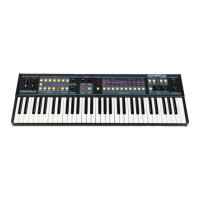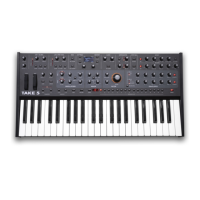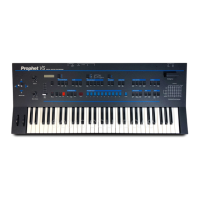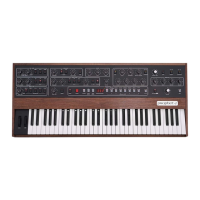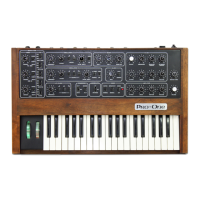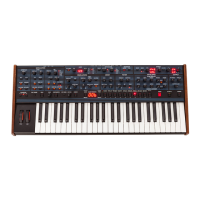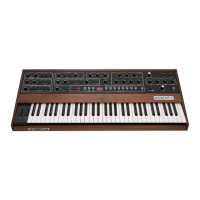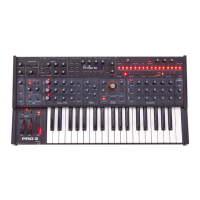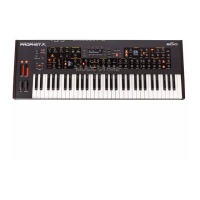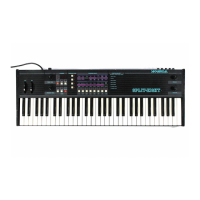Do you have a question about the Sequential TRIGON-6 and is the answer not in the manual?
Details on the Trigon-6's 1000 permanent and user-writable sound banks.
Instructions on how to select and recall synthesizer programs.
Using Inc/Dec buttons to navigate through presets.
Guidance on modifying existing synth programs using front panel controls.
How to identify saved parameter values using the Trigon-6 display.
Procedure for comparing edited sounds to their saved versions.
Steps to create new sounds from a basic preset.
Activating and using the live panel mode for immediate sound shaping.
Instructions for saving created or edited synthesizer programs.
How to abort a program save operation before completion.
Evaluating a target program location before overwriting.
Linking multiple Trigon-6 units via MIDI for increased voice count.
Guidance on tailoring the instrument and exploring advanced features.
The primary switch for powering the synthesizer on and off.
Details on the IEC power input for the Trigon-6.
Using the USB port for bidirectional MIDI communication.
Description of MIDI In, Out, and Thru 5-pin DIN connectors.
Connecting footswitches or audio signals for sequencer/arpeggiator control.
Connecting footswitches for sustain pedal functionality.
Connecting an expression pedal to control overall volume.
Connecting an expression pedal to control the low-pass filter cutoff.
Description of the unbalanced 1/4 inch audio output jacks.
Details on the stereo headphone jack and volume control.
Configuration for parameters like Transpose, Master Tune, and MIDI Channel.
Configuration for parameters like Local Control, MIDI Clock Port, and Param Xmit.
Detailed descriptions of Octave, Pitch, Waveshape, Pulse Width, and Sync settings.
How to adjust the individual volume levels of each oscillator.
Details on Cutoff, Resonance, Env Amount, 2-Pole, and Keyboard tracking settings.
Explanation of Attack, Decay, Sustain, Release, and Velocity controls.
Using Poly Mod section to modify Filter Envelope responsiveness.
Explanation of Attack, Decay, Sustain, Release, and Velocity controls for volume.
List of available effects in sets A and B (reverb, delay, chorus, phaser, flanger).
Controls for Effect On/Off, type selection, Mix, and Clock Sync.
Controls for LFO Frequency, Sync, Shape, Amount, and destinations.
Using Poly Mod for complex modulation routing between sources and destinations.
Quantizing arpeggiator playback to the beat.
Settings for Tap Tempo, BPM, Divide, Octave, and Mode.
Creating sequences with up to 64 steps and 6 notes per step.
Using Bank/Decrement to step backward and correct recorded sequence notes.
Sending sequencer notes as MIDI data to external devices.
Controls for Record, Play, and sequence playback speed settings.
Setting the volume for individual programs using the PGM VOL knob.
Using the DISTORTION knob for stereo analog distortion.
Introducing voice-to-voice parameter variations for warmth.
Adjusting the stereo panning of individual voices.
Adjusting the overall volume of an individual program.
Selecting the pitch bend range in semitones.
Setting key priority for monophonic playback modes.
Transposing the keyboard up or down in octaves.
Enabling notes to sustain until HOLD is turned off.
Understanding Fixed Rate, Fixed Rate A, Fixed Time, and Fixed Time A modes.
Activating Unison mode for monophonic voice stacking.
Memorizing chords in Unison mode for triggered playback.
Using the WRITE button to save the current program.
How to abort a program save before it is committed.
Evaluating a target location before saving a program.
Setting the pitch bend range and using the pitch wheel.
Using the Mod wheel for LFO modulation and expressiveness.
Selecting aftertouch amount and modulation destinations.
Details on how aftertouch affects parameters like pitch, filter, and amplitude.
Description of default and alternative tuning systems supported by the Trigon-6.
Configuration of MIDI channel, clock, ports, transmit/receive, and control settings.
Explanation of System Real-Time, Channel, Controller, and other MIDI message categories.
Details on NRPN and Sysex message formats for parameter transmission.
Suggestions for resolving problems with the sequencer, arpeggiator, and audio output.
Procedure to restore the Trigon-6 OS using boot loader mode.
Contact information for technical assistance and warranty repair details.
| Brand | Sequential |
|---|---|
| Model | TRIGON-6 |
| Category | Synthesizer |
| Language | English |
